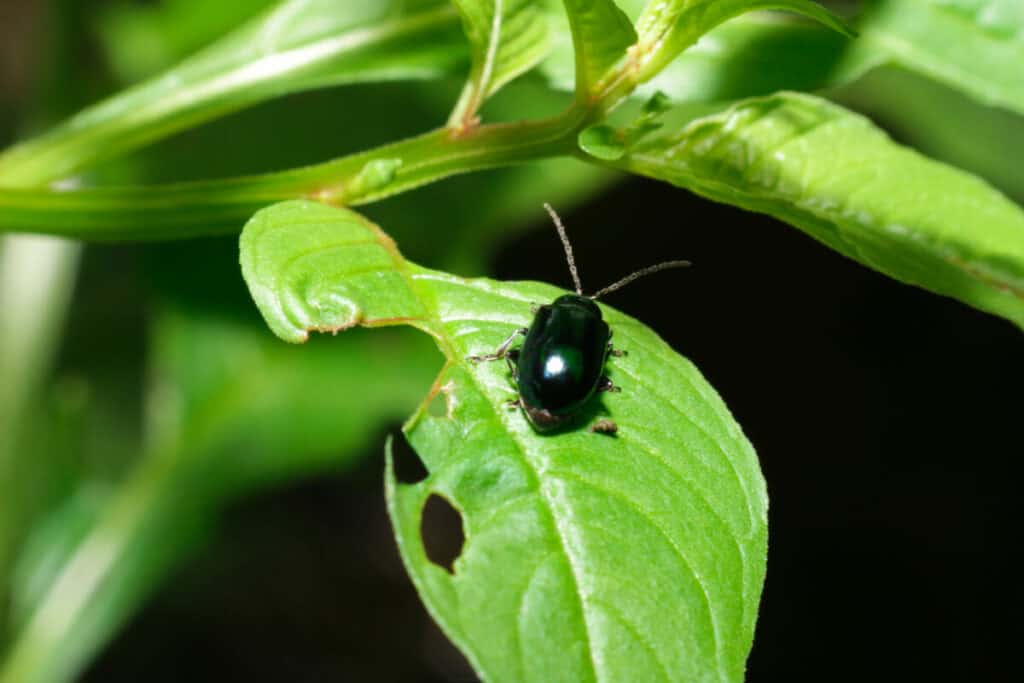If you’re a gardener, chances are you’ve encountered a pesky problem: flea beetles on your vegetable plants. These tiny black or brown insects can wreak havoc on your garden if left unchecked.
In this blog post, we’ll discuss what flea beetles are, how to identify them, and how to get rid of them safely and effectively.
What are flea beetles?
Flea beetles are small, dark-colored insects that measure between 1/16 and 1/8 inches long. They have a distinctive jumping behavior when disturbed, hence the name.
The larvae eat plant roots below the soil, and the adults eat leaves, stems, and fruits of vegetables such as cabbage, tomatoes, potatoes, peppers, and beans.
Flea beetles damage plants by creating small holes in leaves which can stunt or deform growth. In large numbers, they can quickly destroy an entire crop.
What damage do flea beetles cause on plants?
The adult insects feed on plant foliage, leaving behind tiny holes which can stunt or deform growth and eventually kill the plant.
The larvae feed on the roots of vegetables, which can also lead to stunted and deformed growth and eventual death of the plant.
In large numbers, flea beetles can quickly destroy an entire crop of vegetables. They may spread diseases from plant to plant as they move around in search
How to identify flea beetles on plants

You can identify flea beetles by their small size (1/16 to 1/8 inch long) and dark coloration. They can also be recognized by their distinctive jumping behavior when disturbed. Look for tiny holes in the foliage of your plants, as this is a sign that a flea beetle is present.
You may notice clumps or patches of frass (insect excrement) near the damaged foliage; this is another sign of flea beetle infestation. Check your soil for larvae, which are usually found beneath the surface.
Read more:
How to get rid of flea beetles
Neem Oil: Neem oil is an organic pesticide that can get rid of flea beetles on vegetables plants without harming other beneficial insects or wildlife in your area. It works by disrupting the hormones of pests, preventing them from eating or reproducing further.
Insecticidal Soap: Insecticidal soap is a great way to get rid of adult flea beetles quickly and effectively causing no harm to beneficial insects or wildlife in your area.
Diatomaceous Earth: Sprinkling diatomaceous earth around your plants is a great way to keep flea beetles away as it has sharp edges that cut through the exoskeleton of pests.
Read more:
- How To Stop Insects Eating Plant Leaves
- How to Use Neem Oil and Save Your Plants
- How To Use Diatomaceous Earth In Potted Plants
How to prevent flea beetles on plants
Crop rotation: Planting different vegetables in different areas of your garden each year can help prevent flea beetles from building up over time and attacking many plants.
Floating row covers: Using floating row covers to cover your vegetable plants can help keep the flea beetles away from the plants as they cannot penetrate the covering.
Natural predators: Encouraging natural predators like ladybugs, spiders, and praying mantises to live in your garden can help reduce the population of flea beetles as these predators feed on them.
Plant trap crops: Planting certain trap crops such as radishes near susceptible vegetable plants can attract flea beetles away from the main crop, helping to protect it from damage.
Host vegetable plants for flea beetles
Flea beetles attack a wide variety of vegetable plants, including beans, cabbage, carrots, potatoes, and tomatoes.
These insects feed on the foliage of these plants, leaving behind tiny holes which can stunt or deform growth. In large numbers, they can quickly destroy an entire crop.
Other vegetables affected by flea beetle damage include broccoli, cauliflower, melons, peppers and squash.
Natural predators of flea beetles
Flea beetles have a variety of natural predators. These include ladybugs, praying mantises, spiders, and ground beetles.
Ladybugs are effective predators of flea beetles, as they consume large numbers of the pests in their adult and larval stages.
Praying mantises also feed on flea beetles, while spiders trap them in their webs. Ground beetles are also voracious predators of flea beetles.
References
- https://extension.umn.edu/yard-and-garden-insects/flea-beetles
- https://en.wikipedia.org/wiki/Flea_beetle
- https://extension.colostate.edu/topic-areas/insects/flea-beetles-5-592/

Fact Checked, Written, and Published by Kevin Rodrigues
Kevin is the founder of Gardening Mentor, a website that aims to teach people to grow their own food in a limited space. As a self-taught gardener, Kevin has spent several years growing plants and creating gardening content on the website. He is certified in Home Horticulture and Organic Gardening from Oregon State University. He has a Post Graduate Diploma in Horticulture and Landscape Gardening from Mumbai University.
Read more
